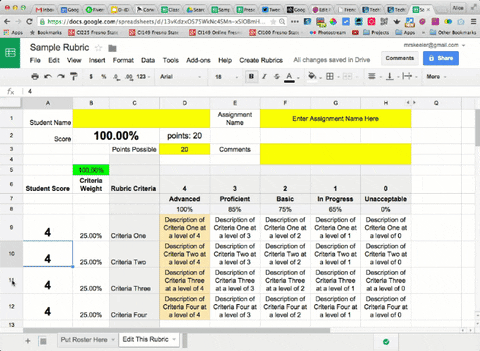I have a favorite method for assessing student learning.
As an assessment professional, I probably shouldn’t favor one over another. All methods have benefits and can be best or most appropriate for a given situation.
Rubrics are my favorite, though.

Free guide: Our Guide to Building Wonderful Rubrics
A simple guide to an essential tool Download For FreeWhile formal definition and description are provided by Stevens and Levi (2005), I think of rubrics as tools to assist in consistent and objective assessment for defined elements. They appear in a grid or table-like form: Scale points across the top forming columns, content to be scored creates the rows, and the row-column intersections depict what should be observed of content at the respective scale point.

Rubrics primarily take two forms: Holistic and analytic.
Holistic rubrics:
Holistic rubrics can be characterized by overarching dimensions with descriptive phrases defined per scale point. They are ideal when there are few elements or content is difficult to differentiate, and there can be more subjectivity in scoring because these rubrics provide one overall score for a given student.
Analytic rubrics:
Analytic rubrics are characterized by multiple, individual dimensions with unique descriptions per scale point. They are best utilized when the list of elements is long. They promote objectivity while providing a score per element, and potentially overall. Folks are likely more familiar with analytic rubrics than holistic ones.
In select instances, I have come across some interesting hybrid rubrics that borrow elements of each style. It is important to know that one type is not better than the other, just perhaps more appropriate for the situation or intended measure.
Rubrics can be used for a variety of situations. For observational purposes, rubrics can be used with presentations, team activities, and trainings. In document analysis, rubrics can be utilized for reflections, portfolios, and visual media or art. Below are some examples of how rubrics can be used in a variety of contexts:
- In classroom settings, they can be used to inform students on expectations for projects, as well as used by faculty to objectively score student work.
- Advisors, counselors, and tutors can use rubrics in observation to note demonstration, achievement, or progression of student learning and behavior in relation to outcomes, goals, or objectives of the intervention.
- Career counselors can use rubrics in resume and cover letter review, as well as interview preparation to score in relation to how a candidate conveys information, style, and professional traits associated with a given industry.
- In comparison situations (such as interviews or technology system demonstrations), rubrics clearly outline important elements for comparative consideration, offering objective and differentiated content to ease evaluation.
Just as there are multiple uses, there are multiple benefits for rubrics:
- Creation promotes collaboration: A good rubric typically involves multiple perspectives in creation or testing.
- Serves multiple audiences: While rubrics are used by the assessor, their content also can communicate expectations to students about what’s expected and how they will be scored.
- Simultaneously provides student feedback and programmatic feedback
- Allows for detailed but efficient feedback: Rubrics should make it easy and quick to score an artifact or observation, plus scores yield built-in descriptive feedback as justification or rationale.
- Promotes consistency: Scale points and descriptions should be clear to understand and help remove any subjectivity or guess work in scoring across instances.
- Yields best of both (data) worlds: Scoring yields quantitative results with qualitative descriptions.
- Results refine practice: Aside from the benefit of clear articulation for rubric content, its results can be used for operational purposes to adjust interventions and associated resources.
While I don’t expect you to fall in love, I hope this overview of rubrics has been an informative introduction or reminder of their purposes. This blog is actually the first of three in a series on rubrics.
The second post will discuss the how-to of creating rubrics, and the final post will discuss how you can best utilize rubric data. Whether you’re all-in for the full series or just this post, I appreciate you reading and learning about these wonderful instruments. Stay tuned!
Editor’s note: This is part one of three in a blog series about rubrics. Be sure to check out part two and part three.





